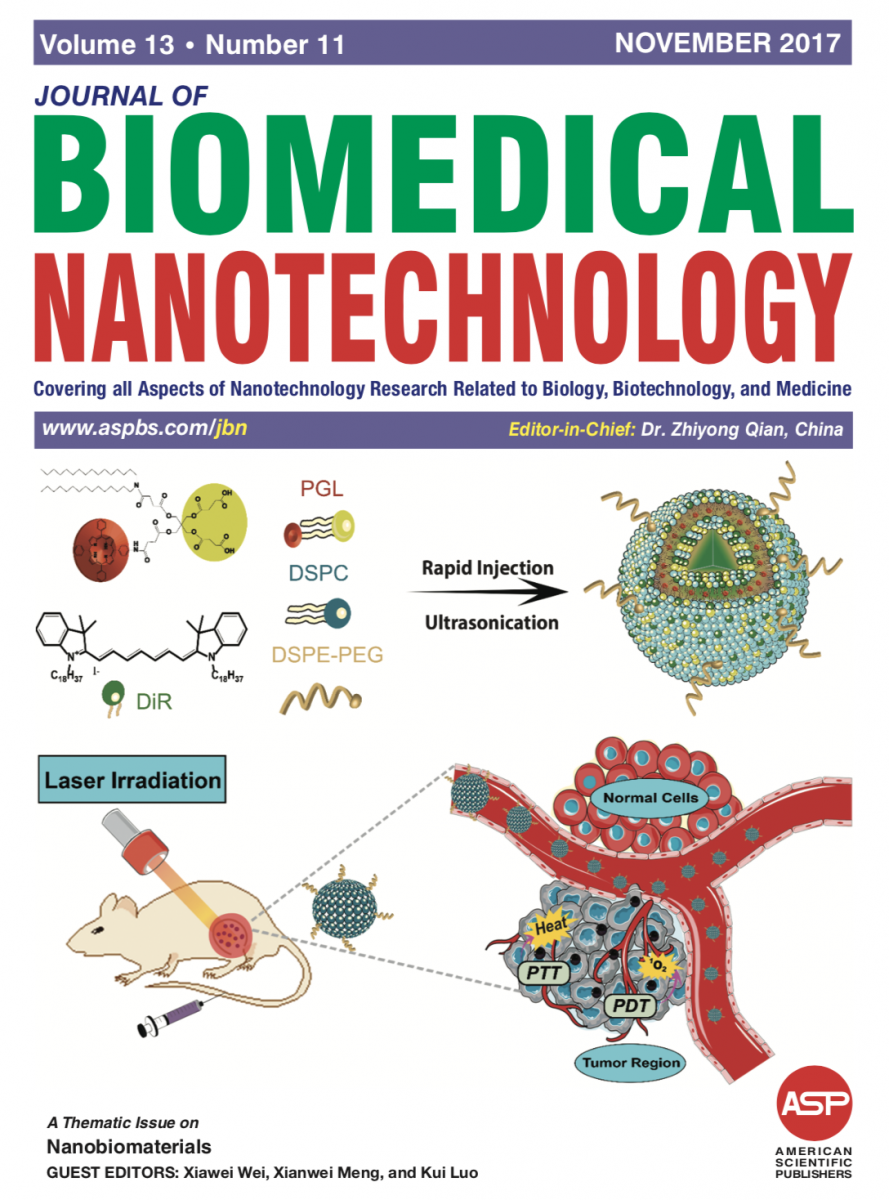肿瘤的微创治疗因其具有创伤小、恢复快、能最大限度保护正常组织器官等优势,已成为肿瘤治疗的有效方法。其中,以光热疗法(PTT)和光动力疗法(PDT)为代表的微创治疗通过将光敏剂所吸收的光能转化成热或产生活性氧,从而有效杀死肿瘤细胞。该类疗法不仅操作简单、副作用小,而且在时间和空间上具有高度选择性,因此在生物医学领域引起了广泛关注。近红外菁染料如吲哚菁绿、DiR等具有很好的光热转化能力,卟啉类衍生物已广泛应用于癌症的光动力治疗。然而,这些小分子光敏剂还存在代谢快、光稳定性差等缺点。而且,肿瘤在实施单一的光动力治疗或光热治疗后容易复发。因此,研制高载药量的纳米载体将近红外菁染料和卟啉同时输送到肿瘤区域,实施光热/光动力联合治疗,通过协同作用提高疗效从而解决肿瘤复发的问题,正成为本领域的重要研究课题。
近日,北京大学工学院生物医学工程系的戴志飞教授团队在肿瘤光诊疗方面取得重要进展。该研究成果以封面论文发表于《Journal of Biomedical Nanotechnology》, A Novel Cyanine and Porphyrin Based Theranostic Nanoagent for Near-Infrared Fluorescence Imaging Guided Synergistic Phototherapy, (2017,13: 1468-1479, doi:10.1166/jbn.2017. 2427)(新型菁染料/卟啉纳米诊疗制剂用于近红外荧光成像引导的协同光疗)。
该文章设计合成了卟啉脂质(PGL),并将其与含有脂质碳链的菁染料衍生物(DIR)通过自组装过程构建了新型的菁染料-卟啉纳米粒子(PGL-DIR),用于前列腺癌的诊断和治疗。该制备策略可根据需要调节纳米载体中卟啉和菁染料衍生物的相对比例,载药量超过30%,而且在载体制备、储存和血液循环输送中可有效避免光敏剂的泄漏,从而可使光热治疗和光动力治疗达到最佳效果。在体外研究中发现,菁染料的引入会一定程度地淬灭卟啉所产生的活性氧,但是通过选择光照的顺序有效解决了这一矛盾。首先,利用760 nm激光的照射肿瘤可以使PGL-DIR粒子中的DIR在发挥光热作用的同时逐渐被漂白,然后再用650 nm的激光照射使PGL-DIR纳米粒子中的卟啉产生活性氧,从而发挥光动力治疗的效果。尾静脉给药后,通过DIR的近红外荧光可观察到PGL-DIR纳米粒子可在小鼠肿瘤中实现高浓度富集。动物治疗结果表明,相比于单独的PTT或者PDT,在连续激光的照射下,PTT + PDT的联合协同治疗可更加有效地抑制肿瘤的生长。这种新型的光诊疗试剂安全、高效,且制备方法简单,在临床转化方面具有很好的前景。
该文章的共同第一作者是北京大学工学院的博士研究生Pravin Bhattarai和北京大学第三医院超声科的梁晓龙博士。论文工作得到国家重点研发计划纳米科技专项(No.2016YFA0201400),国家自然科学基金重点项目(No.81230036),国家科学基金项目面上项目(No.81371580),国家自然科学基金创新团体项目(No.81421004)等多个基金项目的支持。

Abstract
Design and synthesis of multifunctional organic nanoparticles (NPs) for non-invasive diagnosis and phototherapy of cancer are widely acknowledged. However, limited drug loading of NPs are major limitations for attaining synergistic effect in most of the combination therapies. Herein, a novel cyanine-porphyrin combined NPs (PGL-DiR) was fabricated in a simple and inexpensive way for the treatment of prostate cancer. A most commonly used near-infrared fluorescent (NIRF) cyanine dye, DiR was chosen as a photothermal agent to encapsulate in a porphyrin grafted lipid (PGL) (PGL-DiR) NPs of average size 156.25±31.31 nm. Unlike conventional liposomes, the self-assembled PGL morphology revealed encapsulation efficiency of DiR higher than 98%. However, as observed in vitro, DiR loading contents could trigger obvious quenching of singlet oxygen (1O2) by PGL thereby reducing the efficiency of PDT. Nevertheless, after successful photobleaching of DiR, as prepared PGL-DiR NP could facilitate enhanced synergistic photothermal and photodynamic (PTT-PDT) therapy both in vitro and in vivo. After intravenous administration of PGL-DiR NPs in a PC3 tumor xenograft mice, a high accumulation in tumor until 24 hrs was clearly evident via NIRF imaging. With the successive laser irradiation, these NPs effectively suppressed the tumor growth synergistically as PTT < PDT < PTT + PDT while compared to monotherapies such as PTT or PDT alone. These results demonstrated that as prepared PGL-NPs could serve as an excellent theranostic agent both in vitro and in vivo for combined therapy of prostate cancer.